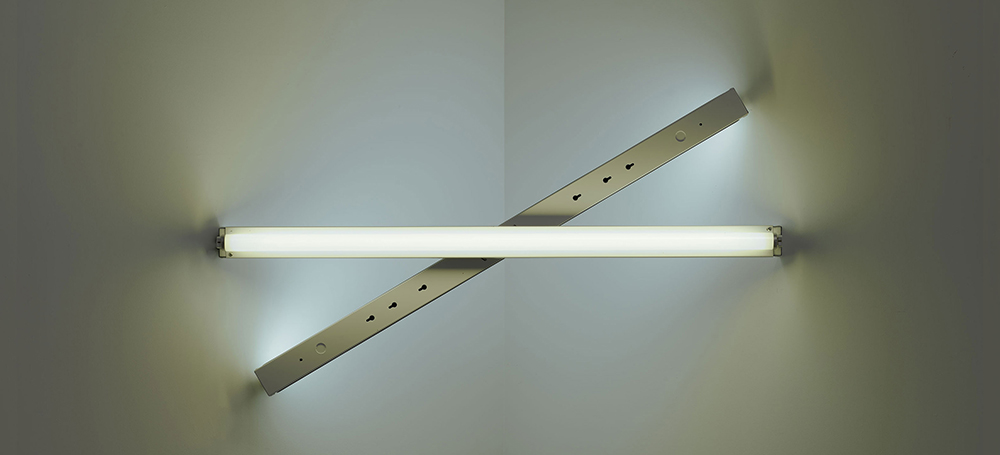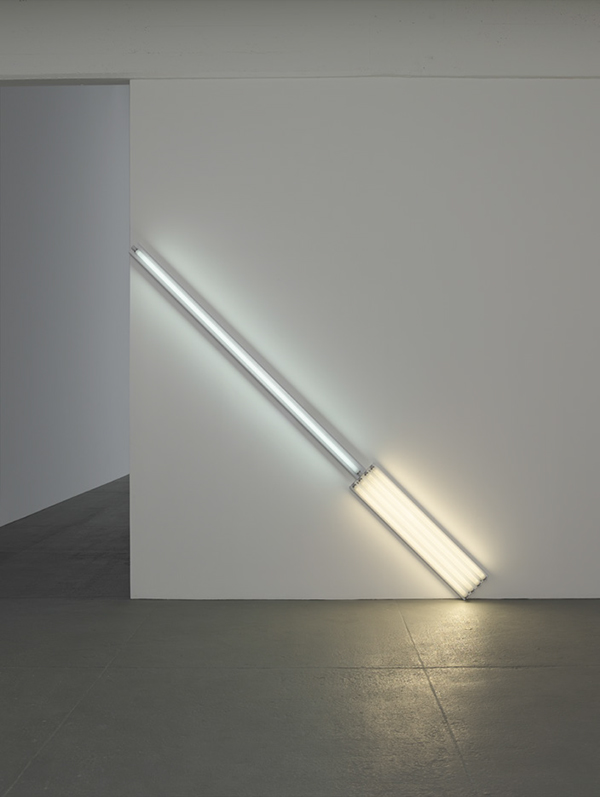ART-PRESENTATION: Dan Fravin-In Daylight or Cool White
 After a brief stint at seminary and meteorological training in the military, Dan Flavin pursued his artistic studies in the late 1950s at Columbia University and the New School. By 1961, he had abandoned his early assemblages of found objects and begun his signature work: sculptural installations made from fluorescent light bulbs.
After a brief stint at seminary and meteorological training in the military, Dan Flavin pursued his artistic studies in the late 1950s at Columbia University and the New School. By 1961, he had abandoned his early assemblages of found objects and begun his signature work: sculptural installations made from fluorescent light bulbs.
By Dimitris Lempesis
Photo: David Zwirner Gallery Archive
Dan Flavin’s work is clean, industrially produced, and serially repeating. These qualities were developed in opposition to the gestural expressionist painting dominant in postwar American art. The use of ordinary light bulbs also references the twin modernist obsessions with pure technology and everyday life. By basing his work as much in radiated light as in the bulbs themselves, Flavin set the stage for much of the experience-oriented installation work that continues today. The exhibition “Dan Flavin: in daylight or cool white” examines Dan Flavin’s use of different variations of fluorescent white light, focusing on significant works from the 1960s. The title refers to Flavin’s seminal text “”… in daylight or cool white” an autobiographical sketch” first published in the December 1965 issue of Artforum. Throughout his career, Dan Flavin experimented with the subtly chromatic and perceptual possibilities afforded by the commercially available variations of “white” fluorescent light (cool white, daylight, warm white, and soft white). The exhibition includes key works from 1963 to the early 1970s, encompassing a period of radical experimentation for the artist and presenting the range of variation he was able to achieve in his constructions. On view are the “diagonal of May 25, 1963” (1963), with the “ecstatic” revelation of the diagonal, Flavin realized the potential of the fluorescent bulb as a basic form that could be built upon and infinitely repeated, not unlike the grooved design of Brancusi’s “Endless Column”. Flavin’s choice of the diagonal refers to the artistic philosophy of early abstractionists like Wassily Kandinsky and Theo van Doesburg, who emphasized the diagonal for its dynamic presence. The “nominal three (to William of Ockham)” (1963), which consists of an additive system of six fluorescent lamps, installed in intervals of one, two, and three vertical 8-foot lamps. Dedicated to the medieval English theologian and philosopher William of Ockham, this work established the use of elemental systems and progressions that would preoccupy Flavin throughout his career. As the artist noted in 1963, “With the nominal three I will exult primary figures and their dimensions. Here will be the basic counting marks (primitive abstractions) restated long in the daylight glow of common fluorescent tubes”. Other works on view combine different variations of white light, such as “alternate diagonals of March 2, 1964 (to Don Judd)” (1964), which experiments with the distinct effects of daylight and cool white lamps. Also included in the exhibition is “untitled” (1964), a curving arc of seven 2-foot fixtures. The work was first presented in Flavin’s 1966 solo exhibition at Galerie Rudolf Zwirner, Cologne, and comprises a rare curved format for the artist, extending from the wall on the floor into the exhibition space. Significant early examples of Flavin’s “monuments” for V. Tatlin are included. The works are a distant rendition of Tatlin’s “Monument to the Third International”. It is one of 39 so-called monuments to the Russian Constructivist artist, Vladimir Tatlin, who Flavin held in extremely high regard. Meant to be an office building built according to the ideals of Constructivism, Tatlin’s “Third International” was never constructed, although the plans for the monument remain a symbol of the movement. Flavin’s Monuments, made up of light bulbs that either burn out or are turned off, have an element of impermanence that memorializes the ghost of Tatlin’s unrealized project. As Flavin stated, “The pseudo-monuments, structural designs for clear but temporary cool white fluorescent lights, were to honor the artist ironically”.
Info: David Zwirner Gallery, 537 West 20th Street, New York, Duration: 21/2-14/4/18, Days & Hours: Tue-Sat 10:00-18:00, www.davidzwirner.com

